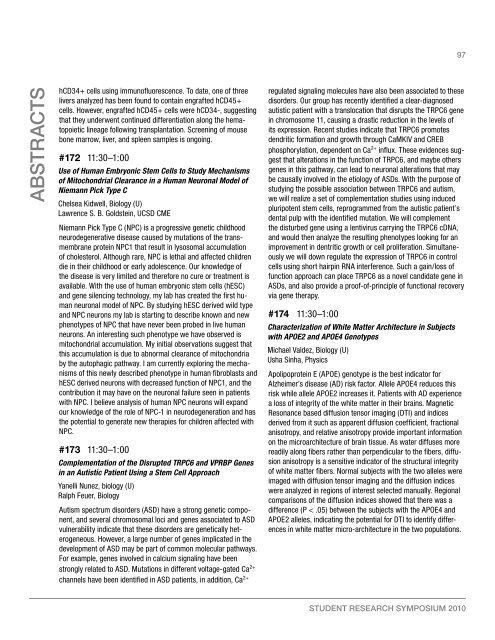STUDENT RESEaRch SympoSiUm 2010 - Graduate and Research ...
STUDENT RESEaRch SympoSiUm 2010 - Graduate and Research ...
STUDENT RESEaRch SympoSiUm 2010 - Graduate and Research ...
You also want an ePaper? Increase the reach of your titles
YUMPU automatically turns print PDFs into web optimized ePapers that Google loves.
AbstrActs<br />
hCD34+ cells using immunofluorescence. To date, one of three<br />
livers analyzed has been found to contain engrafted hCD45+<br />
cells. However, engrafted hCD45+ cells were hCD34-, suggesting<br />
that they underwent continued differentiation along the hematopoietic<br />
lineage following transplantation. Screening of mouse<br />
bone marrow, liver, <strong>and</strong> spleen samples is ongoing.<br />
#172 11:30–1:00<br />
Use of Human Embryonic Stem Cells to Study Mechanisms<br />
of Mitochondrial Clearance in a Human Neuronal Model of<br />
Niemann Pick Type C<br />
Chelsea Kidwell, Biology (U)<br />
Lawrence S. B. Goldstein, UCSD CME<br />
Niemann Pick Type C (NPC) is a progressive genetic childhood<br />
neurodegenerative disease caused by mutations of the transmembrane<br />
protein NPC1 that result in lysosomal accumulation<br />
of cholesterol. Although rare, NPC is lethal <strong>and</strong> affected children<br />
die in their childhood or early adolescence. Our knowledge of<br />
the disease is very limited <strong>and</strong> therefore no cure or treatment is<br />
available. With the use of human embryonic stem cells (hESC)<br />
<strong>and</strong> gene silencing technology, my lab has created the first human<br />
neuronal model of NPC. By studying hESC derived wild type<br />
<strong>and</strong> NPC neurons my lab is starting to describe known <strong>and</strong> new<br />
phenotypes of NPC that have never been probed in live human<br />
neurons. An interesting such phenotype we have observed is<br />
mitochondrial accumulation. My initial observations suggest that<br />
this accumulation is due to abnormal clearance of mitochondria<br />
by the autophagic pathway. I am currently exploring the mechanisms<br />
of this newly described phenotype in human fibroblasts <strong>and</strong><br />
hESC derived neurons with decreased function of NPC1, <strong>and</strong> the<br />
contribution it may have on the neuronal failure seen in patients<br />
with NPC. I believe analysis of human NPC neurons will exp<strong>and</strong><br />
our knowledge of the role of NPC-1 in neurodegeneration <strong>and</strong> has<br />
the potential to generate new therapies for children affected with<br />
NPC.<br />
#173 11:30–1:00<br />
Complementation of the Disrupted TRPC6 <strong>and</strong> VPRBP Genes<br />
in an Autistic Patient Using a Stem Cell Approach<br />
Yanelli Nunez, biology (U)<br />
Ralph Feuer, Biology<br />
Autism spectrum disorders (ASD) have a strong genetic component,<br />
<strong>and</strong> several chromosomal loci <strong>and</strong> genes associated to ASD<br />
vulnerability indicate that these disorders are genetically heterogeneous.<br />
However, a large number of genes implicated in the<br />
development of ASD may be part of common molecular pathways.<br />
For example, genes involved in calcium signaling have been<br />
strongly related to ASD. Mutations in different voltage-gated Ca 2+<br />
channels have been identified in ASD patients, in addition, Ca 2+<br />
97<br />
regulated signaling molecules have also been associated to these<br />
disorders. Our group has recently identified a clear-diagnosed<br />
autistic patient with a translocation that disrupts the TRPC6 gene<br />
in chromosome 11, causing a drastic reduction in the levels of<br />
its expression. Recent studies indicate that TRPC6 promotes<br />
dendritic formation <strong>and</strong> growth through CaMKIV <strong>and</strong> CREB<br />
phosphorylation, dependent on Ca 2+ influx. These evidences suggest<br />
that alterations in the function of TRPC6, <strong>and</strong> maybe others<br />
genes in this pathway, can lead to neuronal alterations that may<br />
be causally involved in the etiology of ASDs. With the purpose of<br />
studying the possible association between TRPC6 <strong>and</strong> autism,<br />
we will realize a set of complementation studies using induced<br />
pluripotent stem cells, reprogrammed from the autistic patient’s<br />
dental pulp with the identified mutation. We will complement<br />
the disturbed gene using a lentivirus carrying the TRPC6 cDNA,<br />
<strong>and</strong> would then analyze the resulting phenotypes looking for an<br />
improvement in dentritic growth or cell proliferation. Simultaneously<br />
we will down regulate the expression of TRPC6 in control<br />
cells using short hairpin RNA interference. Such a gain/loss of<br />
function approach can place TRPC6 as a novel c<strong>and</strong>idate gene in<br />
ASDs, <strong>and</strong> also provide a proof-of-principle of functional recovery<br />
via gene therapy.<br />
#174 11:30–1:00<br />
Characterization of White Matter Architecture in Subjects<br />
with APOE2 <strong>and</strong> APOE4 Genotypes<br />
Michael Valdez, Biology (U)<br />
Usha Sinha, Physics<br />
Apolipoprotein E (APOE) genotype is the best indicator for<br />
Alzheimer’s disease (AD) risk factor. Allele APOE4 reduces this<br />
risk while allele APOE2 increases it. Patients with AD experience<br />
a loss of integrity of the white matter in their brains. Magnetic<br />
Resonance based diffusion tensor imaging (DTI) <strong>and</strong> indices<br />
derived from it such as apparent diffusion coefficient, fractional<br />
anisotropy, <strong>and</strong> relative anisotropy provide important information<br />
on the microarchitecture of brain tissue. As water diffuses more<br />
readily along fibers rather than perpendicular to the fibers, diffusion<br />
anisotropy is a sensitive indicator of the structural integrity<br />
of white matter fibers. Normal subjects with the two alleles were<br />
imaged with diffusion tensor imaging <strong>and</strong> the diffusion indices<br />
were analyzed in regions of interest selected manually. Regional<br />
comparisons of the diffusion indices showed that there was a<br />
difference (P < .05) between the subjects with the APOE4 <strong>and</strong><br />
APOE2 alleles, indicating the potential for DTI to identify differences<br />
in white matter micro-architecture in the two populations.<br />
<strong>STUDENT</strong> RESEARCH SYMPOSIUM <strong>2010</strong>


